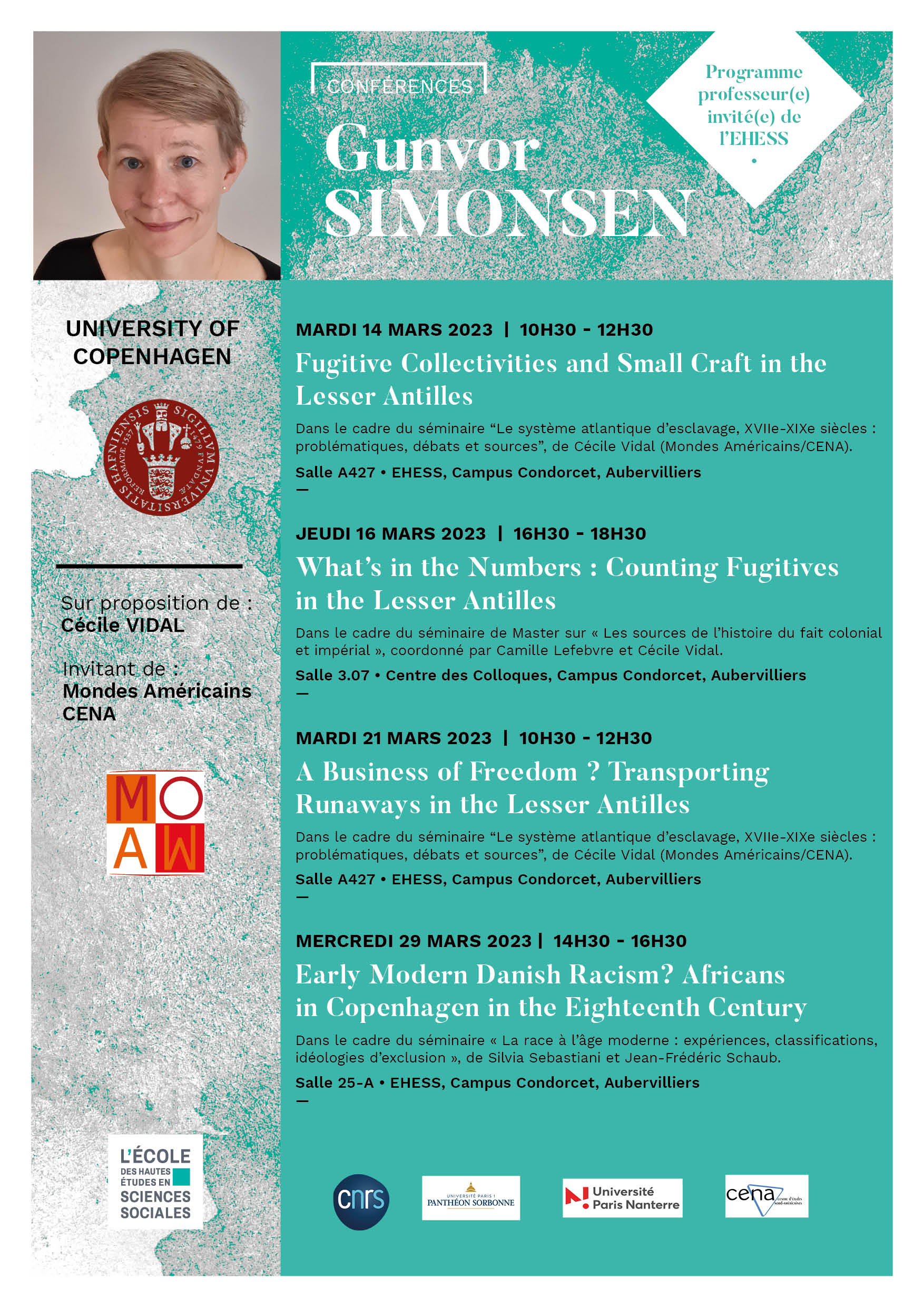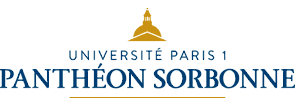Actualités du laboratoire | 2022-2024
Conférences de Gunvor Simonsen, professeure à l’Université de Copenhague, Danemark
Les 14, 16, 21 et 29 mars 2023
Gunvor Simonsen is associate professor of history at University of Copenhagen, Denmark.
She specializes in eighteenth- and nineteenth-century Atlantic history. Her particular focus is on Caribbean cultural and social history but she has also worked with West African and Danish Atlantic history. Her research explores questions about government, gender, religion, and race in the US Virgin Islands when they were under Danish rule. She leads the research project In the Same Sea, funded by the European Research Council.
Her book Slave Stories: Law, Representation, and Gender in the Danish West Indies (2017) reconstructs the narratives crafted by enslaved men and women during legal proceedings in the Danish West Indies and argues that contested notions of gender enabled some enslaved to challenge Danish colonial legal power. Her latest research has resulted in the anthology Global Biographies: Lived History as Method, edited with L. Almagor and H.A. Ikonomou (2022).
Gunvor Simonsen participe au Programme professeurs invités de l’EHESS. Elle est invitée par Cécile Vidal, (Mondes Américains/CENA).
Conférences
1. Fugitive Collectivities and Small Craft in the Lesser Antilles
Dans le cadre du séminaire "Le système atlantique d'esclavage, XVIIe-XIXe siècles : problématiques, débats et sources", de Cécile Vidal (Mondes Américains/ CENA).
• Mardi 14 mars 2023 de 10h30 à 12h30
EHESS - Campus Condorcet, salle A427
2, Cours des Humanités, Aubervilliers
In this seminar, I will focus on maritime marronage in the Lesser Antilles in the eighteenth and nineteenth centuries. The Jamaican historian Neville Hall developed the notion of maritime marronage in his work on the fugitive practices of enslaved Africans and African Caribbeans on the Danish Caribbean islands, St. Thomas, St. John and St. Croix. In doing so, Hall drew on the work Gabriel Debien, whose categorization of petit versus grand marronage still shapes our historiography. Yet Hall argued that in the relatively small Danish islands opportunities for grand marronage disappeared when cane fields came to cover most land. Consequently, in these heavily cultivated small islands, there were few, if any, places for enslaved fugitives to seek shelter. No maroon societies emerged such as those known from the Greater Antilles, the Caribbean rim of South America and Brazil. Instead, with few land-based opportunities, slaves looking for permanent escape took to the sea.
Since Hall’s contribution, historians and archeologists have increasingly sought to include maritime maroons in their stories of Caribbean slave societies. With some exceptions, previous studies of maritime marronage have focused on flights shaped by the infrastructure afforded by large Atlantic vessels and the long distance trade conducted out of port towns. Indeed, versions of the following narrative string recurs in studies of seaborne flight: Enslaved people, more precisely enslaved men, escaped to port towns. Here they could hide in the relative anonymity provided by densely populated urban centers, perhaps receiving assistance from free people of color. In these port towns, fugitive slaves sought hire as sailors on ships awaiting departure. Sometimes captains played along to attract crew, other times enslaved men succeeded in passing for free. In this seminar, I will aim to expand our understanding of maritime marronage by zooming in on the archipelagic infrastructure of small craft. I hope to argue that small open boats afforded fugitive opportunities to groups, in particular women and children, who are often excluded from our present historiography. Rural estates rather than harbor towns became fugitive spaces, families and groups rather than single individuals organized and executed escape. As such, an appreciation of the ubiquitous presence of small craft along the shorelines of the islands of the Lesser Antilles provides a more complex and inclusive understanding of marronage in the Caribbean.
2. What’s in the Numbers : Counting Fugitives in the Lesser Antilles
Dans le cadre du séminaire de Master sur "Les sources de l'histoire du fait colonial et impérial", coordonné par Camille Lefebvre et Cécile Vidal.
• Jeudi 16 mars 2023 de 16h30 à 18h30
Centre de colloques, Campus Condorcet, salle 3.07.
Place du Front populaire, Aubervilliers
In this seminar, I share the experiences of constructing a database containing runaway notices brought in Lesser Antillean newspapers and working with the quantitative datasets resulting from the database. I will address the following questions: What are the choices that go into database construction? How do we balance coverage of data versus quality of data? How do we ensure that data obtains evidential value? And what does this kind of data actually show us? How do we establish a relevant context - in this case the printing histories of the Lesser Antilles, the chattel principle of racial slavery, and the fugitive practices of slaves - that qualify our data interpretation?
In her recent book, Reckoning with Slavery, Jennifer L. Morgan unpacks the challenges of using numerical data for the study of Atlantic slavery. Focusing on the large datasets of the Transatlantic Slave Trading Database (https://www.slavevoyages.org/), Morgan questions if the voyage datasets present a reliable picture of the gendered composition of the early transatlantic slave trade, and she arguing for a mode of historical interpretation that triangulates a larger variety of sources. In a similar vein, we may begin to ask how we can complicate the picture that emerges from the counting of runaway notices in the Lesser Antillean newspapers: a picture that will feature more men than women and more single individuals than groups. How does the ‘genre’ of the runaway notice shape the potential knowledge we can glean from these datasets? And what are the analytical strategies, we can develop to circumvent how white notions of slave ownership and mastery effaced the practices and motives of enslaved men and women who escaped their owners.
3. A Business of Freedom ? Transporting Runaways in the Lesser Antilles
Dans le cadre du séminaire "Le système atlantique d'esclavage, XVIIe-XIXe siècles : problématiques, débats et sources", de Cécile Vidal (Mondes Américains/ CENA).
• Mardi 21 mars 2023 de 10h30 à 12h30
EHESS - Campus Condorcet, salle A427
2, Cours des Humanités, Aubervilliers
In the seminar, I look at maritime marronage in the Lesser Antilles in the first half of the nineteenth century. While eighteenth-century evidence suggests that fugitive men and women built or stole the boats or rafts they needed to execute escape, a number of nineteenth-century incidents, recorded in the Danish, Dutch and British archives, suggest that maritime marronage had developed into a business. Some captains, sailors, and fishermen, often free people of color and non-elite whites, had established a business model that catered to the needs and dreams of enslaved who wanted to escape their islands. Cruising between islands, using agents to reach those enslaved who wanted to flee, these traffickers entered into agreement with relatively large groups of slaves, terms were agreed upon, and transport prices were fixed. Indeed, flight came to depend on the financial resources of individual slaves: those who could pay for the sail, could hope to attain freedom or at least other living conditions on their island of destination.
This close-up look at marronage as a business for some adds another layer to our understanding of the conditions and circumstance that afforded flight opportunities to slaves in the Caribbean. And conversely, it underscores how slavery on small, unsustainable islands, sat in motion inter-island connections. The need and wish for a better life, perhaps possible on nearby islands across the sea, generated a number of inter-island institutions and practices. Administrative procedures for extradition, inter-island news circulation and law-making, maritime maroon hunts, and the establishment of what appear to be a fairly institutionalized transportation or trafficking business, with common procedures and perhaps even set prices. As such, slavery in the Lesser Antilles was not a landlocked regime, but extended into the Caribbean Sea, shaping how islanders engaged with one another across islands and empires.
4. "Early Modern Danish Racism? Africans in Copenhagen in the Eighteenth Century"
Dans le cadre du séminaire "La race à l'âge moderne : expériences, classifications, idéologies d'exclusion", de Silvia Sebastiani et Jean-Frédéric Schaub.
•
Mercredi 29 mars 2023 de 14h30 à 16h30
EHESS - Campus Condorcet, salle 25-A
2, Cours des Humanités, Aubervilliers
In this seminar, I focus on how race, slavery and commerce shaped life for Africans and African Caribbeans in Copenhagen, the capital of the Danish-Norwegian double monarchy, in the eighteenth century. Racial categories had been firmly established in Denmark’s Caribbean (today the US Virgin Islands) possessions from early colonization in the 1670s. Racial ideas also permeated Danish merchants’ travel literature about the Gold Coast (Ghana and Benin) and slowly came to shape the encounter between slave traders at Fort Christiansborg and people in Osu, the town adjacent to the fort. In Copenhagen, the financial center of the Danish colonial empire, a vernacular of race also emerged. Racial ideas came to Copenhagen as detailed news from the wider Atlantic was brought in the relatively small Copenhagen press, they were made available to Copenhageners in a small number of travel accounts, and they also flowed in the households of absentee planters, colonial officers, merchants and noblemen and -women with money and prestige invested in colonial ventures.
In Copenhagen, as in most other European capitals and towns engaged in the transatlantic slave trading system, the concepts constituting the tool kit of racism and its construction of races enabled the categorization of people into supposedly recognizable and uncomplicated groups. Indeed, Atlantic racism contained the claim that its concepts were universally applicable. They applied across time and space. Yet, by zooming in on Copenhagen in the eighteenth century, I hope to show that such universal claims failed because racial concepts needed to attain local traction in order to become effective and forceful. Atlantic racism, in other words, changed as it circulated in the Danish colonial capital Copenhagen.
♦ Voir l'affiche
 Actualités
Actualités
Journées d’études doctorales du laboratoire Mondes Américains
 Journée(s) d'étude - Jeudi 6 juin 2024 - 09:00Comité d’organisation (avec l'appui de l'équipe administrative de Mondes Américains) :Elisa Cerón (CRBC), Quentin Lacombe (CENA/LARCA), Samuel Libeau (CRALMI), Calixte Madej (CRALMI), Elie Pucheral (CERMA) et Érico Saad Campos (CRBC)Les journées d'ét (...)(...)
Journée(s) d'étude - Jeudi 6 juin 2024 - 09:00Comité d’organisation (avec l'appui de l'équipe administrative de Mondes Américains) :Elisa Cerón (CRBC), Quentin Lacombe (CENA/LARCA), Samuel Libeau (CRALMI), Calixte Madej (CRALMI), Elie Pucheral (CERMA) et Érico Saad Campos (CRBC)Les journées d'ét (...)(...)
Les Rendez-vous de Mondes Américains
 Rencontres scientifiques - Mercredi 24 avril 2024 - 09:00Le laboratoire Mondes Américains (UMR 8168) vous invite à la troisième édition des Rendez-vous de Mondes Américains, consacrés à la présentation, aux commentaires et à la discussion de quatre ouvrages récents et d'un film documentaire des (...)(...)
Rencontres scientifiques - Mercredi 24 avril 2024 - 09:00Le laboratoire Mondes Américains (UMR 8168) vous invite à la troisième édition des Rendez-vous de Mondes Américains, consacrés à la présentation, aux commentaires et à la discussion de quatre ouvrages récents et d'un film documentaire des (...)(...)
Entretien avec Marie Assaf, doctorante de l'EHESS, sur l’état de la recherche sur les politiques du handicap
Échos de la recherche -Doctorante de l'EHESS en Études Politiques (Centre d'études nord-américaines - Laboratoire Mondes américains), Marie Assaf travaille sur les politiques d'emploi à destination des personnes handicapées aux États-Unis. À travers son analyse ethnographique des pratiques et di (...)(...)
Mondes Américains -
UMR 8168
EHESS
2, cours des Humanités
93322 Aubervilliers cedex
France
Tél. : +33 (0)1 88 12 03 99
Communication :
T. +33 (0) 1 88 12 03 44





